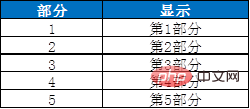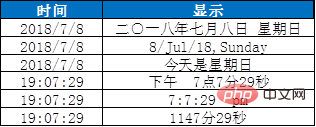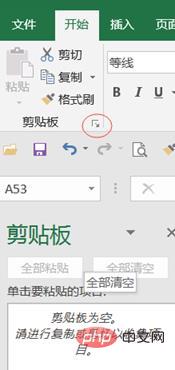Practical Excel Tips Sharing: The Magical 'Custom Format” Function
In the previous article "Sharing practical Excel skills: batch creation/splitting of worksheets, batch renaming of worksheets", we learned two methods of setting up worksheets. Today we are going to learn the "custom format" function. After learning the custom format, we can deal with many problems without using functions.

In the default cell format of EXCEL software, it is usually a numerical value, date or text, etc. So is there any way to make the characters in the cell display in the format we want? Today I will introduce to you a very useful function: custom format.
1. How to open custom format
Select any cell, click the "Home" tab, and click on the right side of "Number Group" There is an extension button in the lower corner. Click to bring up the "Format Cells" dialog box.

You can also directly press the shortcut key Ctrl 1 to bring up the dialog box shown below. Click "Number" - "Custom". Under "Type" on the right is where we need to fill in the custom format code. After clicking OK, the characters in the cell will be displayed as we want.

2. Introduction to basic custom functions
The custom format code is divided into four areas Sections are separated by half-width semicolons (;). The code of each section acts on different types of values:
Positive number display format; Negative number display format; Zero value display format; text display format
In addition, it is also very simple to use custom formats to display colors for characters. Just add [red] and other words to the custom code. Characters display corresponding colors. The colors can display the following: [Black], [Green], [White], [Blue], [Magenta], [Yellow], [Teal], [Red].
3. Main application scenarios of custom formats
3.1 The percentage increase is shown
in As shown in the table below, the positive and negative numbers in the last column of data are marked with different colors, and the up and down arrows represent the positive and negative signs.

The custom format code is:
[Red]↑0%;[Green]↓0%;0%;
Analysis: There are four areas separated by semicolons. The first area represents the positive area and displays red; the second area represents the negative area and displays green. 0 is a numerical placeholder. , displays the value itself, followed by % to display the percentage; the third area is the zero value display format, and the color defaults to black; the last area is text, and if there is no text in the table, fill in nothing.
3.2 Add text display
In the table shown below, I want to set the number in the first column to the display format of the second column.

Usually everyone uses the text connector & to connect text. Here we directly use the custom format code to set it to: Part 0
Analysis: 0 represents a placeholder for a number, just add text before and after.
As shown below, if the numbers in the first column are Chinese numbers, they need to be set to be displayed in the format of the second column.

Then the custom format is set to: Part @
Analysis: @ represents the occupancy of the text Character.
3.3 Numbers are displayed in Chinese
If we need to display the numbers in column 1 as shown below in the Chinese style of columns 2 and 3, generally Chinese will be entered directly when typing. Of course, custom formats can also help you realize this function very conveniently.

Chinese lowercase custom format code is set to: [DBNUM1]
Chinese uppercase custom format code is set to: [DBNUM2]
3.4 Segmented display of numbers
At work, we also need to display values of different lengths in segments, as shown below:

The custom format code for segmented display is set to:
0000 0000 0000
Analysis: Use 0 as a placeholder and add a space to display in segments.
The custom format code without adding 0 in front of the segmented display is set to:
??00 0000 0000
Analysis: If we don’t want 0 is automatically added to the front of the value, and if you want the value to be displayed in alignment, you can use ? to replace the 0 displayed previously, here? The number of depends on the maximum number of previously displayed 0s.
However, since EXCEL can fully display numbers within 11 digits; the number of numerical digits is greater than 11 digits but not more than 15 digits. EXCEL displays scientific notation as 9.03525E 13. You can use the above automatic Define the format code so that it is fully displayed; numbers over 15 will be displayed as 0, so the method used here does not work for values over 15 digits. For values exceeding 15 digits, we can only modify the format to text to display them all.
3.5 Date and time display
In the table shown below, the date and time in the first column need to be displayed in the format of the second column.

The custom format code settings in the table above are:
The first one: [DBNum1]yyyy"year"m"month"d"day " aaaa
The second one: d/mmm/yy,dddd
The third one: Today is aaaa
The fourth one: morning/afternoon h"point"m "minutes"s"seconds"
The fifth one:h:m:s am/pm
The sixth one:[m]minutes s seconds
Analysis: This The English letters inside are the English initials of year, month, day, hour, minute and second. The number of letters determines the number of characters in the display format.
In the date format, yy represents 18, while yyyy represents 2018; m and mm represent the months 7 and 07 displayed in numerical values, and mmm and mmmm represent the months Jul (abbreviation) and July (full name) displayed in English. ); In the same way, d and dd represent the dates 8 and 08 displayed in numerical values, and ddd and dddd represent the days of the week Sun (abbreviation) and Sunday (full name) displayed in English.
In the time format, if m needs to represent minutes, it needs to be displayed together with h hours, or [ ] is added to represent the number of minutes accumulated from zero o'clock on the day to the present, which means that hours are also converted into minutes.
If you need to express the day of the week in Chinese, you need to use the letter a. Aaaa displays Sunday, and aaa displays only the day.
4. Issues to note
It should be noted that custom formatting does not change the format of the cell itself, only changes it display mode.
In the table shown below, the uppercase Chinese numbers in column C are converted from the custom format code set by the numbers in column A. Let’s try to see if the Chinese numbers in column C can be summed?
Enter the formula in column D:
SUM($C$30:C30). Double-click to fill it down. You can see the cumulative summation results as follows.

It can be concluded that although the cells in column C are displayed in Chinese capitals, they are actually numerical values and can be used for mathematical operations.
Of course, if we need to convert the custom format into an actual numerical format, we can use the clipboard to copy, and then copy the data in the clipboard to the cell.

#Or copy it into a word or txt document and then paste it back into the cell to complete the format conversion.
Okay, that’s all the introduction to EXCEL’s custom formats
Related learning recommendations: excel tutorial
The above is the detailed content of Practical Excel Tips Sharing: The Magical 'Custom Format” Function. For more information, please follow other related articles on the PHP Chinese website!

Hot AI Tools

Undresser.AI Undress
AI-powered app for creating realistic nude photos

AI Clothes Remover
Online AI tool for removing clothes from photos.

Undress AI Tool
Undress images for free

Clothoff.io
AI clothes remover

Video Face Swap
Swap faces in any video effortlessly with our completely free AI face swap tool!

Hot Article

Hot Tools

Notepad++7.3.1
Easy-to-use and free code editor

SublimeText3 Chinese version
Chinese version, very easy to use

Zend Studio 13.0.1
Powerful PHP integrated development environment

Dreamweaver CS6
Visual web development tools

SublimeText3 Mac version
God-level code editing software (SublimeText3)

Hot Topics
 1659
1659
 14
14
 1416
1416
 52
52
 1310
1310
 25
25
 1258
1258
 29
29
 1233
1233
 24
24
 What should I do if the frame line disappears when printing in Excel?
Mar 21, 2024 am 09:50 AM
What should I do if the frame line disappears when printing in Excel?
Mar 21, 2024 am 09:50 AM
If when opening a file that needs to be printed, we will find that the table frame line has disappeared for some reason in the print preview. When encountering such a situation, we must deal with it in time. If this also appears in your print file If you have questions like this, then join the editor to learn the following course: What should I do if the frame line disappears when printing a table in Excel? 1. Open a file that needs to be printed, as shown in the figure below. 2. Select all required content areas, as shown in the figure below. 3. Right-click the mouse and select the "Format Cells" option, as shown in the figure below. 4. Click the “Border” option at the top of the window, as shown in the figure below. 5. Select the thin solid line pattern in the line style on the left, as shown in the figure below. 6. Select "Outer Border"
 How to filter more than 3 keywords at the same time in excel
Mar 21, 2024 pm 03:16 PM
How to filter more than 3 keywords at the same time in excel
Mar 21, 2024 pm 03:16 PM
Excel is often used to process data in daily office work, and it is often necessary to use the "filter" function. When we choose to perform "filtering" in Excel, we can only filter up to two conditions for the same column. So, do you know how to filter more than 3 keywords at the same time in Excel? Next, let me demonstrate it to you. The first method is to gradually add the conditions to the filter. If you want to filter out three qualifying details at the same time, you first need to filter out one of them step by step. At the beginning, you can first filter out employees with the surname "Wang" based on the conditions. Then click [OK], and then check [Add current selection to filter] in the filter results. The steps are as follows. Similarly, perform filtering separately again
 How to change excel table compatibility mode to normal mode
Mar 20, 2024 pm 08:01 PM
How to change excel table compatibility mode to normal mode
Mar 20, 2024 pm 08:01 PM
In our daily work and study, we copy Excel files from others, open them to add content or re-edit them, and then save them. Sometimes a compatibility check dialog box will appear, which is very troublesome. I don’t know Excel software. , can it be changed to normal mode? So below, the editor will bring you detailed steps to solve this problem, let us learn together. Finally, be sure to remember to save it. 1. Open a worksheet and display an additional compatibility mode in the name of the worksheet, as shown in the figure. 2. In this worksheet, after modifying the content and saving it, the dialog box of the compatibility checker always pops up. It is very troublesome to see this page, as shown in the figure. 3. Click the Office button, click Save As, and then
 How to set superscript in excel
Mar 20, 2024 pm 04:30 PM
How to set superscript in excel
Mar 20, 2024 pm 04:30 PM
When processing data, sometimes we encounter data that contains various symbols such as multiples, temperatures, etc. Do you know how to set superscripts in Excel? When we use Excel to process data, if we do not set superscripts, it will make it more troublesome to enter a lot of our data. Today, the editor will bring you the specific setting method of excel superscript. 1. First, let us open the Microsoft Office Excel document on the desktop and select the text that needs to be modified into superscript, as shown in the figure. 2. Then, right-click and select the "Format Cells" option in the menu that appears after clicking, as shown in the figure. 3. Next, in the “Format Cells” dialog box that pops up automatically
 How to use the iif function in excel
Mar 20, 2024 pm 06:10 PM
How to use the iif function in excel
Mar 20, 2024 pm 06:10 PM
Most users use Excel to process table data. In fact, Excel also has a VBA program. Apart from experts, not many users have used this function. The iif function is often used when writing in VBA. It is actually the same as if The functions of the functions are similar. Let me introduce to you the usage of the iif function. There are iif functions in SQL statements and VBA code in Excel. The iif function is similar to the IF function in the excel worksheet. It performs true and false value judgment and returns different results based on the logically calculated true and false values. IF function usage is (condition, yes, no). IF statement and IIF function in VBA. The former IF statement is a control statement that can execute different statements according to conditions. The latter
 How to type subscript in excel
Mar 20, 2024 am 11:31 AM
How to type subscript in excel
Mar 20, 2024 am 11:31 AM
eWe often use Excel to make some data tables and the like. Sometimes when entering parameter values, we need to superscript or subscript a certain number. For example, mathematical formulas are often used. So how do you type the subscript in Excel? ?Let’s take a look at the detailed steps: 1. Superscript method: 1. First, enter a3 (3 is superscript) in Excel. 2. Select the number "3", right-click and select "Format Cells". 3. Click "Superscript" and then "OK". 4. Look, the effect is like this. 2. Subscript method: 1. Similar to the superscript setting method, enter "ln310" (3 is the subscript) in the cell, select the number "3", right-click and select "Format Cells". 2. Check "Subscript" and click "OK"
 Where to set excel reading mode
Mar 21, 2024 am 08:40 AM
Where to set excel reading mode
Mar 21, 2024 am 08:40 AM
In the study of software, we are accustomed to using excel, not only because it is convenient, but also because it can meet a variety of formats needed in actual work, and excel is very flexible to use, and there is a mode that is convenient for reading. Today I brought For everyone: where to set the excel reading mode. 1. Turn on the computer, then open the Excel application and find the target data. 2. There are two ways to set the reading mode in Excel. The first one: In Excel, there are a large number of convenient processing methods distributed in the Excel layout. In the lower right corner of Excel, there is a shortcut to set the reading mode. Find the pattern of the cross mark and click it to enter the reading mode. There is a small three-dimensional mark on the right side of the cross mark.
 How to insert excel icons into PPT slides
Mar 26, 2024 pm 05:40 PM
How to insert excel icons into PPT slides
Mar 26, 2024 pm 05:40 PM
1. Open the PPT and turn the page to the page where you need to insert the excel icon. Click the Insert tab. 2. Click [Object]. 3. The following dialog box will pop up. 4. Click [Create from file] and click [Browse]. 5. Select the excel table to be inserted. 6. Click OK and the following page will pop up. 7. Check [Show as icon]. 8. Click OK.




